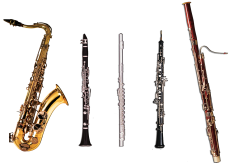
Musical instruments differ in many properties, but just like many things in life, there is a simple method we use to classify them. Instruments are generally separated into groups based on how the sound is produced. Once such group is the woodwind instruments.
Wind instruments involve the player blowing air into a resonator tube, which causes vibrations inside the tube. The pitch of the sound, which determines what note is played differs dependant on the length of the tube, and can also be modified by effectively changing the length of the tube, often by pressing buttons on the outside of the instrument. They differ primarily from brass instruments in the material used to make them, which is almost completely brass in the latter, and in the use of a reed to blow air in, which is used in almost all woodwind instruments.
Woodwind instruments are amongst the hardest to play. Though the fingerings for the different notes may not be that hard to remember, the technical aspect of producing the sound can be hard to master. When I first picked up a flute, it took me days before I could even get the correct sound to be released. If you can whistle to begin with, it may help. They can be somewhat exhausting instruments to play as well, because the player has to provide a lot of power breathing into the instrument to make the noise. Different instruments in the family are played in different ways. Most have a wooden reed which is used to blow directly into the tube, but flutes, for example simply have a hole at one end, which you have to half-blow into for the sound to be made. Woodwind instruments are mainly used in orchestral music, but they are found here and there in popular music and can also be found in jazz bands. We’ll now consider some individual instruments and their use.
The bassoon is usually the lowest woodwind instrument used. It is quite a long tube held diagonally across the body, with a strap to help the instrumentalist to support it. It is so big compared to the other instruments in the family because it is lower than the others, and in both woodwind and brass instruments, size relates to the lowness of the pitch. With a bigger tube, there is more space for sound to resonate, producing a lower pitch. Then buttons around the edge of the tube are pressed in various arrangements to produce different notes in the octave. However, in order to produce the notes of a different octave, the mouth shape is changed. This is another technique that is particularly hard to learn when first starting to play a woodwind instrument.
Another popular woodwind instrument is the oboe. This is, like the Bassoon, a tube made of wood. They are shorter than the Bassoon, giving them a higher pitch. Oboes have a double-reed at the end (a term we’ll explain more in a later article), which is blown through to create sound, and there are once again buttons along the tube which are pressed to change the note being played. You can see immediately from my descriptions of these two instruments how very similar many of the instruments of the woodwind family are. The main differences between them are in size (which changes pitch), exact fingerings of notes, and method for inputting air. In the next article, I’ll discuss in more detail how pressing the buttons actually changes the notes, and why different instruments have different apparatus for breathing into them.
Image from: http://www.ugrad.cs.ubc.ca/~a4e0b/woodwinds.png

0 Comment:
Be the first one to comment on this article.